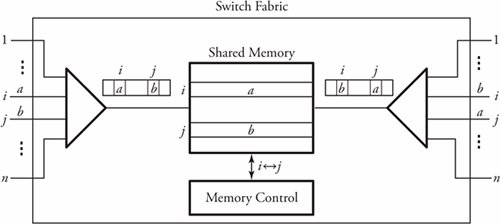Section 13.6. Shared-Memory Switch Fabrics
13.6. Shared-Memory Switch FabricsA totally different approach for switching can be achieved in time domain and without using any switch elements: the shared-memory switch fabric . As shown in Figure 13.11, the distinctive feature of this switch fabric is the use of a high-speed n : 1, time-division multiplexer (TDM) with a bit rate n times as large as the rate on each individual input/output line. Assume packet a at input i needs to be switched on output j and that packet b at input j is supposed to be switched on output i . First, the multiplexer creates an n -channel-long frame from the n inputs. Each frame created at the output of the multiplexer is stored in shared memory in the same order as the frame's channels. Thus, a is written at location i , and b is written at location j of memory. Figure 13.11. Shared-memory switch fabric To implement the switching action between the two channels i and j , the memory control exchanges the reading order of the two memory locations i and j . This way, the new frame made out of memory contains packet a placed in channel j and packet b placed in channel i . This frame is scanned by a demultiplexer for output ports. If the memory partition for an output is empty, the corresponding minislot remains unfilled. It is a matter of implementation whether frame size in shared memory should be rigid or flexible. Clearly, variable-size frames require more sophisticated hardware to manage, but the packet-loss rate improves , since memory does not suffer from overflow until all memory slots are occupied. See Chapter 3 for more on multiplexers handling variable- size frames . |
EAN: 2147483647
Pages: 211
- Key #3: Work Together for Maximum Gain
- When Companies Start Using Lean Six Sigma
- Making Improvements That Last: An Illustrated Guide to DMAIC and the Lean Six Sigma Toolkit
- The Experience of Making Improvements: What Its Like to Work on Lean Six Sigma Projects
- Six Things Managers Must Do: How to Support Lean Six Sigma